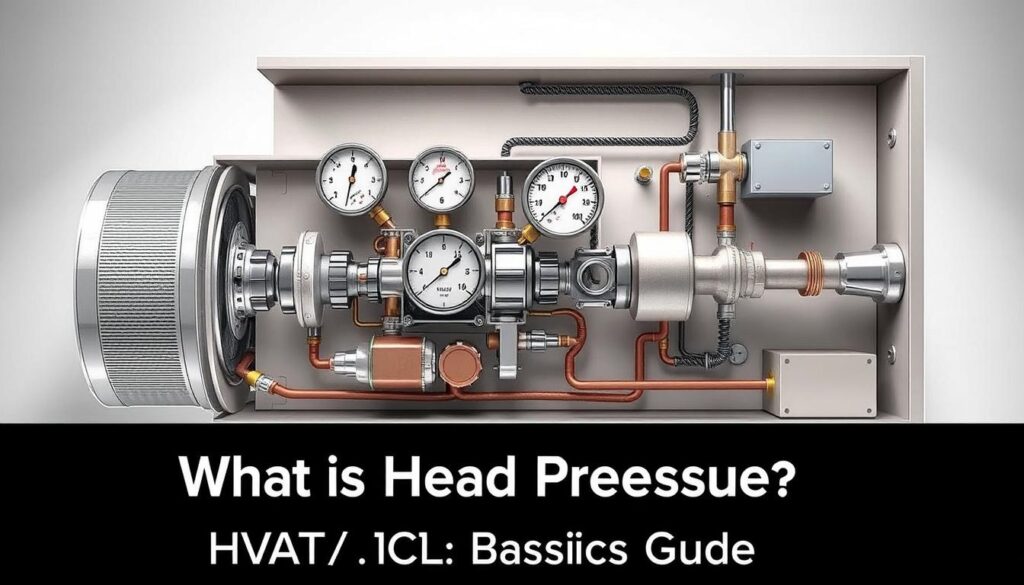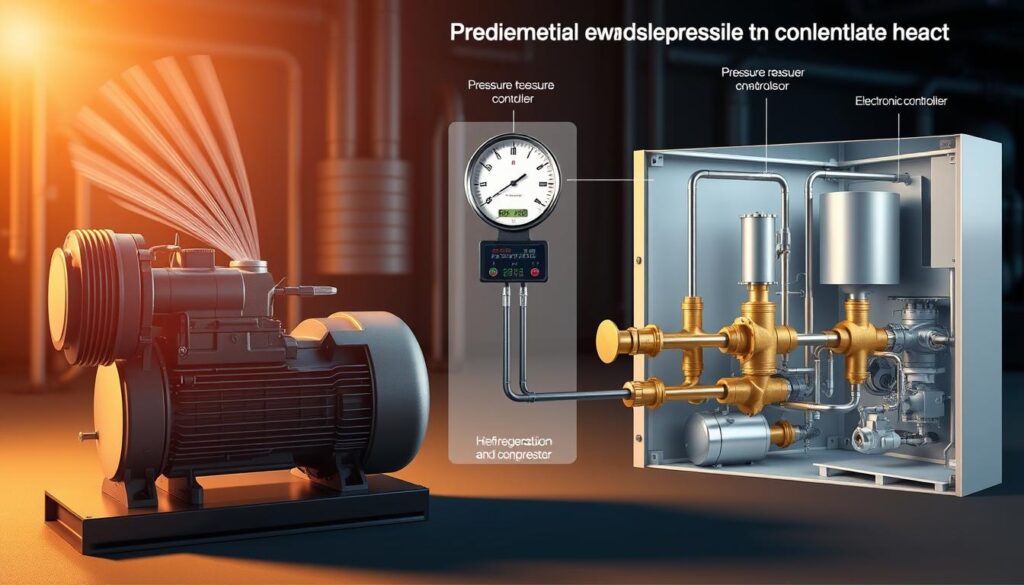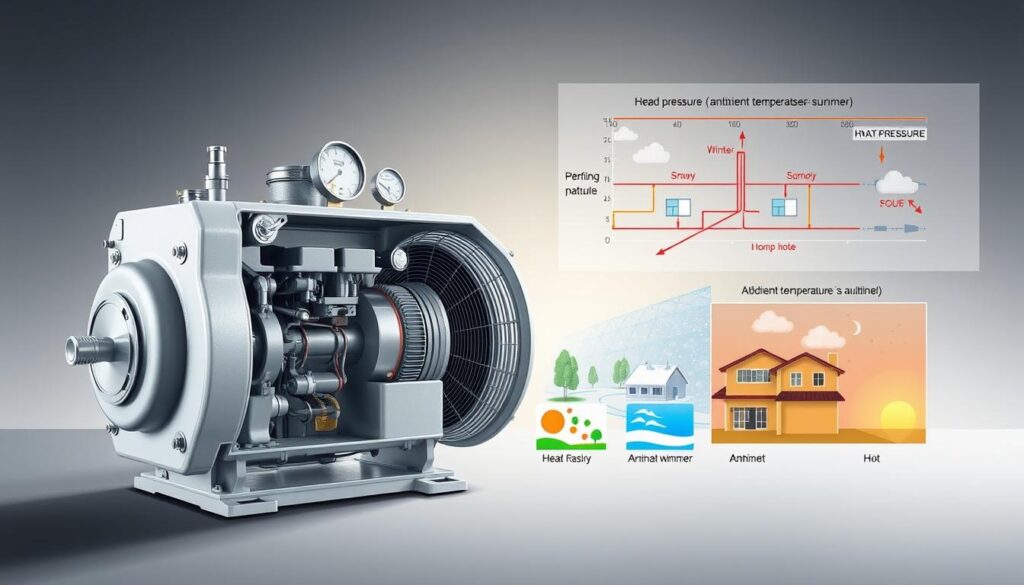Affiliate Disclosure
HVAC Guide Guys is a participant in the Amazon Services LLC Associates Program, an affiliate advertising program designed to provide a means for sites to earn advertising fees by advertising and linking to Amazon.
What is Head Pressure HVAC? Ever thought about the invisible forces that keep your AC running well? Learning about head pressure in HVAC systems might help your system work better and more efficiently.

Head pressure is a key part of HVAC systems. It shows the pressure of refrigerant gas after it leaves the compressor. Keeping an eye on these readings is important for your AC’s health and avoiding breakdowns.
Exploring head pressure in HVAC reveals it’s not just a technical term. It’s a key sign of how well your system is working. It gives you important clues about its performance and any possible problems.
Key Takeaways
- Head pressure measures refrigerant gas pressure after compression
- Monitoring head pressure helps prevent HVAC system failures
- Understanding pressure readings supports optimal system efficiency
- Head pressure reflects the overall health of your air conditioning system
- Regular pressure checks can extend HVAC equipment lifespan
Table of Contents
Understanding Head Pressure in HVAC Systems
Head pressure is key in HVAC systems’ refrigeration cycle. The compressor moves refrigerant at certain pressure levels. Knowing these pressures helps keep your system running well.
Role of Head Pressure in Refrigeration
The compressor head pressure is the high-side pressure in your cooling system. It increases the pressure of the refrigerant gas after the compressor. This high pressure is then sent to the condenser.
- Compresses refrigerant gas
- Increases system pressure
- Facilitates heat transfer
Normal Operating Ranges for Different Systems
Each HVAC system has its own head pressure range. Your refrigerant head pressure chart will show these differences. They depend on the system type and the temperature around it.
| System Type | Low Temp Range (PSI) | Normal Temp Range (PSI) | High Temp Range (PSI) |
|---|---|---|---|
| Residential AC | 150-200 | 200-250 | 250-300 |
| Commercial Refrigeration | 100-180 | 180-230 | 230-280 |
| Industrial Cooling | 180-220 | 220-270 | 270-320 |
Impact on System Performance
Keeping the right head pressure is vital for your HVAC system’s efficiency. Wrong pressure can cause less cooling, more energy use, and damage. Regular checks help avoid these problems and keep your system working best.
“Proper head pressure management is the key to long-lasting HVAC performance.” – HVAC Professional
What is Head Pressure HVAC
Knowing about head pressure in HVAC systems is key to keeping them running well. Head pressure, or discharge pressure, shows the pressure of refrigerant gas leaving the compressor. It’s a vital sign of your system’s health and how well it works.
Exploring head pressure in HVAC reveals it’s a basic measurement that shows how your system is doing. It’s like a temperature check for your air conditioning system.
- Measures refrigerant pressure at compressor discharge
- Indicates system performance and possible issues
- Key for HVAC head pressure troubleshooting
HVAC experts use head pressure readings to find problems. High or low pressures can mean there’s a mechanical issue that needs fixing right away. Keeping an eye on these pressures helps avoid expensive repairs and keeps your system running smoothly.
Measuring head pressure involves special gauges that connect to the refrigerant lines. Technicians use these readings to understand your HVAC system’s refrigeration cycle.
Accurate head pressure measurement is the key to proactive HVAC maintenance.
Understanding head pressure helps you keep your HVAC system efficient and long-lasting. Regular checks and professional inspections can catch problems early. This way, you avoid big issues later on.
Explore Our HVAC Shop
Looking for top-rated HVAC tools, parts, and accessories? Visit our shop and find the perfect solution for your needs.
Visit the ShopComponents Affecting Head Pressure
It’s important to know what parts affect head pressure in an HVAC system. Each part has a big role in keeping the system running well. They help manage pressure and avoid problems.
Compressor Function and Operation
The compressor is the heart of your HVAC system. It makes the refrigerant gas high-pressure and hot. If it doesn’t work right, it can change the system’s pressure a lot.
- Increases refrigerant temperature
- Generates high-pressure gas
- Drives refrigerant circulation
Condenser Coil Performance
Condenser coils are key for cooling. Dirty or blocked coils can really raise head pressure. If they’re clogged, they can’t cool well, putting strain on the system.
| Coil Condition | Heat Release Efficiency | Head Pressure Impact |
|---|---|---|
| Clean Coils | Excellent | Normal |
| Moderately Dirty | Reduced | Elevated |
| Severely Blocked | Poor | Significantly High |
Refrigerant Flow Control Devices
Expansion valves and capillary tubes control refrigerant flow. They affect hvac pressure readings. These devices help the refrigerant flow smoothly, keeping the system running well.
Keeping these parts in good shape is vital to avoid high head pressure problems.
Common Causes of High Head Pressure
Knowing why your HVAC system has high head pressure is key. When your system’s discharge pressure goes up, it means there’s a problem. You need to fix it fast.
There are a few main reasons for high head pressure in HVAC systems:
- Dirty Condenser Coils: Dirt and debris stop heat from transferring well, leading to high pressure
- Refrigerant Overcharge: Too much refrigerant puts extra stress on the system and raises pressure
- Blocked Airflow: When air can’t move freely, it can’t take heat away
- Non-Condensable Gases: Gases that shouldn’t be there mess up the cooling process
- Incorrect Refrigerant Type: Using the wrong refrigerant harms your system’s performance
When fixing high head pressure, techs check these important spots. Each problem is different and can hurt your system’s work and energy use.
“Finding and fixing high head pressure early stops expensive damage and keeps your cooling working well.”
Keeping up with maintenance and getting expert checks can spot and fix these issues early. This way, you avoid bigger problems later on.
Low Head Pressure Problems and Symptoms
Understanding low head pressure in your HVAC system is key to keeping it running well. It can signal problems that might harm your cooling system’s performance.
Low head pressure symptoms show up in several important ways. If your HVAC system has low pressure, you might see:
- Less cooling power
- Frosting on evaporator coils
- Temperature that’s not steady
- More energy used
Signs of Insufficient Head Pressure
Spotting low hvac pressure readings needs careful watching. Common signs include:
- Weak airflow from vents
- Warm air instead of cool air
- Compressor working hard to keep up
- Ice on refrigerant lines
Impact on System Operation
Low head pressure can really mess with your HVAC system’s work. It might come from leaks, bad compressor valves, or harsh weather. These problems can make cooling less effective and might damage your system over time.
Prompt diagnosis and professional help are vital when you keep seeing low head pressure signs.
Experts say it’s smart to have your system checked often. This helps catch and fix low head pressure issues before they cost a lot to fix.
Head Pressure Control Methods
Managing head pressure is key for HVAC systems to work well. You need the right head pressure control valve and good troubleshooting techniques.
Explore Our HVAC Shop
Looking for top-rated HVAC tools, parts, and accessories? Visit our shop and find the perfect solution for your needs.
Visit the Shop
- Fan Cycling Control: Stops and starts condenser fans to keep system pressure right
- Condenser Fan Speed Control: Changes fan speed to control refrigerant temperature and pressure
- Pressure-Regulating Valves: Controls refrigerant flow and system pressure
Each method has its own benefits for different HVAC systems. Fan cycling is good for smaller systems. Variable speed fans are better for complex setups.
When fixing head pressure problems, technicians must look at system specs, environment, and needs. Choosing the right control method boosts system efficiency and avoids mechanical issues.
Proper head pressure control is the key to maintaining your HVAC system’s long-term performance and reliability.
Measuring and Monitoring Head Pressure
It’s key to know how to measure head pressure in refrigeration systems. This helps keep your HVAC running well. Getting accurate readings can spot problems early.
Measuring head pressure needs special tools and methods. Experts use specific gear to get exact readings.
Essential Tools for Measurement
- Digital manifold gauge set
- Temperature probe
- Infrared thermometer
- Pressure transducer
Recommended Reading Techniques
Here are the steps to measure head pressure:
- Make sure the system is stable
- Connect gauges to service ports with care
- Record the room temperature
- Check readings against what the maker says
“Accurate pressure measurements are the key to preventing system failures.” – HVAC Professional
Watch the discharge line temperature closely. If it’s too hot (above 225°F), your compressor could get damaged. Always wear safety gear and ask a pro if you’re not sure.
Keeping an eye on head pressure helps understand your system’s health. By watching these readings, you can see when maintenance is needed and avoid sudden failures.
Relationship Between Head and Suction Pressure
Understanding the relationship between head and suction pressure is key for efficient HVAC systems. These pressures are vital in the refrigeration cycle. They affect your system’s performance and energy use.
Head pressure vs suction pressure is a basic check for HVAC techs. The discharge side has much higher pressure than the suction side. If these pressures are off, your system might struggle a lot.
“Pressure is the language of HVAC systems – learn to listen, and you’ll understand their health.” – HVAC Engineering Principles
- Head pressure shows the high-pressure side of the refrigeration cycle
- Suction pressure shows the low-pressure side of the system
- Keeping pressure balanced is key for system efficiency
Things that can change the head and suction pressure relationship include:
- Ambient temperature
- Refrigerant charge levels
- Compressor performance
- Condenser and evaporator conditions
| Pressure Type | Typical Range | System Impact |
|---|---|---|
| Head Pressure | 150-350 PSI | Discharge side performance |
| Suction Pressure | 50-100 PSI | Cooling efficiency |
By watching these pressure readings closely, you can spot problems early. This can save you from expensive repairs. Regular checks by pros keep the balance right.
Head Pressure in Different Weather Conditions

Weather affects your HVAC system’s performance, mainly in refrigerant head pressure readings. Most systems work best in certain temperature ranges. The usual limit is a maximum outdoor temperature of 95° F.
Extreme weather changes your system’s head pressure a lot. In hot, humid summers, your system faces big challenges. It has to work harder to cool spaces, which affects head pressure.
- Hot Weather Impact:
- Increased condensing unit workload
- Higher refrigerant head pressure chart readings
- Potential system strain
- Cold Weather Considerations:
- Reduced system efficiency
- Potential pressure inconsistencies
- Need for specialized cold-weather components
To tackle these issues, use system design that fits your local climate. Proper maintenance and knowing your weather can prevent head pressure problems.
Watching your HVAC system’s performance in different weather is key to keeping it reliable and efficient for a long time.
Explore Our HVAC Shop
Looking for top-rated HVAC tools, parts, and accessories? Visit our shop and find the perfect solution for your needs.
Visit the ShopTroubleshooting Head Pressure Issues
When you face head pressure problems in your HVAC system, it’s important to troubleshoot carefully. Knowing what causes high head pressure helps you fix issues fast. This way, you avoid bigger problems later.
Diagnostic Steps for Head Pressure Problems
To solve hvac head pressure issues, follow a step-by-step plan. First, check these key spots:
- Inspect condenser coils for dirt and debris
- Verify refrigerant charge levels
- Check airflow restrictions
- Examine condenser fan operation
Common High Head Pressure Causes
Figuring out why head pressure is high is key. Look out for these main culprits:
| Problem Area | Potential Cause | Recommended Action |
|---|---|---|
| Condenser Coils | Excessive dirt buildup | Thorough cleaning |
| Refrigerant System | Overcharged system | Adjust refrigerant levels |
| Airflow | Blocked ventilation | Clear obstructions |
Practical Solutions for Pressure Management
To manage head pressure, try these strategies:
- Clean condenser coils regularly
- Ensure proper refrigerant charge
- Maintain unobstructed airflow
- Replace faulty components promptly
Pro tip: Regular maintenance prevents most head pressure problems and extends your HVAC system’s lifespan.
Maintenance Tips for Optimal Head Pressure
Keeping your HVAC system in top shape is key. Regular care stops head pressure issues and makes your system last longer. A good maintenance plan is vital for fixing hvac head pressure problems.
- Clean condenser and evaporator coils every three months
- Check refrigerant levels and pressure
- Inspect airflow paths indoors and outdoors
- Verify system controls and electrical connections
It’s important to track how your system is doing. Keep a detailed maintenance log to record:
| Maintenance Item | Frequency | Key Checks |
|---|---|---|
| Coil Cleaning | Quarterly | Remove debris, check for damage |
| Refrigerant Pressure | Bi-annually | Measure and adjust charge levels |
| Electrical Inspection | Annually | Check connections, test controls |
“Preventive maintenance is the key to long-lasting HVAC performance and efficiency.” – HVAC Professional Insight
Be careful not to overcharge your system. More refrigerant doesn’t mean better cooling. Always stick to the manufacturer’s guidelines and use professional tools for checking pressures.
By following these maintenance tips, you’ll avoid head pressure issues. Your HVAC system will run efficiently all year round.
Conclusion
Knowing about head pressure in HVAC systems is key to keeping your cooling system running well. By watching and maintaining your system closely, you can make it last longer and work better.
Fixing HVAC head pressure issues early is important. Regular checks, accurate pressure readings, and quick fixes can stop big problems. Keeping an eye on discharge pressure helps avoid expensive repairs and keeps your cooling system working right.
Today’s HVAC systems need advanced pressure control. New tech helps us better watch and manage system pressures. Keeping up with these changes helps you make better choices for your cooling setup.
Learning about head pressure will help your system run smoothly, use less energy, and last longer. Start now to improve your HVAC system’s performance and efficiency.

